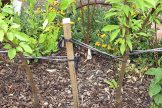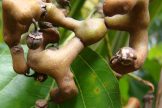
The past decade has seen a wide recognition of the benefits and qualities of heritage and non-commercially grown fruit and vegetable varieties.
Commercially grown fruit and vegetables must have certain qualities such as uniformity, ease of harvesting, good travel and storage qualities all of which can be ignored by the home gardener. There is no need to compromise on flavour, texture, colour, aroma and fun when you grow your own. Heritage varieties have been around for centuries because people have enjoyed eating them, with the less appealing varieties disappearing over time. The end result is some simply stunning varieties to chose from, often with wonderful quirky characteristics. There are new cultivars being developed or found (nature did the work) by dedicated gardeners and horticulturalists all the time.
There is great charm and satisfaction in understanding, growing and eating fruit from your own garden. Researching the history of the variety, appreciating its specific qualities and how and when to eat it, all deepen the indefinable enjoyment of sharing the fruit from your garden with family and friends.
A more pragmatic reason for maintaining our heirloom varieties is genetic diversity and the knowledge that once a variety is extinct, it is unavailable for any future use and any potential benefits lost forever.
Worldwide there are thousands of heritage fruit varieties. In Australia there are far fewer, but still many to choose from. At BAAG, we are developing our range of heritage and uncommon varieties, trying to pick ones which will do well in Melbourne / Victoria and are both interesting and useful.
Heritage fruit can be tricky to source, so give us a call or pop in to see what (if any) varieties we currently have in stock.




